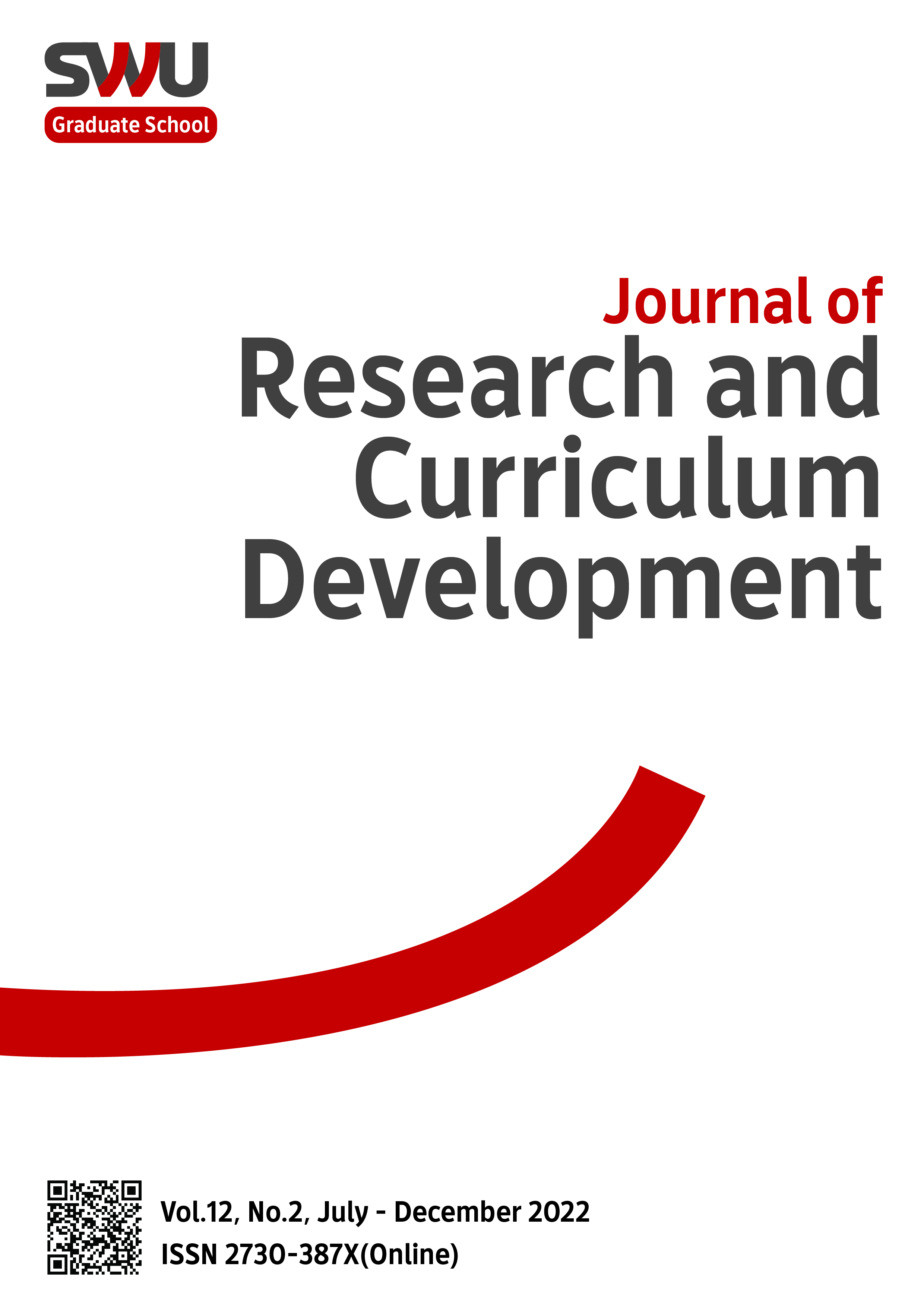Development of Gamification Learning Environment Model Using Design-Based Learning to Enhance Innovative Thinking of Undergraduate Students in Education
Keywords:
การเรียนรู้ในสภาพแวดล้อมแบบเกมิฟิเคชัน, การออกแบบเป็นฐาน, การคิดเชิงนวัตกรรมAbstract
The objectives of this research were to 1) develop gamification learning environment model using design-based learning to enhance innovative thinking of undergraduate students in education; 2) study the trial results of the developed learning model; and 3) analyze the students’ opinions on the developed model after learning. The samples were 30 undergraduate students at Nakhon Pathom Rajabhat University who enrolled the Educational Innovation Course in the second semester of the academic year 2021. The research instruments were an interview form of the experts, a website based on gamification learning, and lesson plans. The research instruments were an innovative thinking assessment form, work evaluation criteria, and an opinion questionnaire on the developed model. The arithmetic mean, standard deviation, and t-test were used for data analysis. The results of this research found that the model for gamification learning environment using design-based learning to enhance innovative thinking of undergraduate students in education consisted of six components, according to the development of learning model of Joyce, Weil and Calhoun (2009). There were 1) theory and principles, 2) objectives, 3) syntax, 4) social system, 5) principles of reaction gamification, and 6) support system. The process of design-based learning consists of seven steps: 1) learning innovation, 2) brainstorming and identifying problems, 3) challenging ideas and finding innovation, 4) summarizing innovation creation concept, 5) creating innovative work, 6) presenting work, and 7) evaluating work. Regarding the results of the model implementation, the students’ innovative thinking ability after learning with the developed model was higher than before learning with the statistical significance level of .05. The students’ opinion on the developed model was at the high level.
References
Reference
[In Thai]
Channarong Wisetsat (2019). The development of teaching model to promote innovative teaching skills for pre-service teachers. Humanities and Social Sciences Journal, Ubon Ratchathani Rajabhat University. 10(2) (July - December 2019), 305-320.
Rattama Rattanawongsa (2011). Development of an instructional model in gamified learning environment with design-based learning and visual tools to enhance visual literacy and achievement motivation for undergraduate students. (Doctoral Degree in Education), Chulalongkorn University.
Sonchai Bootkeaw (2013). Development of thought pattern in designing for visual communication (Doctor of Philosophy). King Mongkut’s University of Technology North Bangkok.
Suchanya Yuangklang (2017). The Development of Blended Learning System by Using Gamification Based Learning to Enhance the Mathematics Problem Solving Skills and Connection Skills to Real Life for Primary schools. Doctor of Philosophy in Educational Technology and Communication, Mahasarakham University.
Tissana Khammanee. (2000). “Thinking and Thinking Instruction.” In Compilation of Articles on Learning Innovation for Teachers in Educational Revolution Era. Bangkok: Faculty of Education, Chulalongkorn University.
Wichai Wongyai and Marut Phatthon. (2019) Development of innovative skills. Online publication on Center of Curriculum and Learning Innovation Leaders. Bangkok, 6-7.
[In English]
Australian National Training Authority (ANTA). (2001). Innovation: Ideas That Work for Trainers of
Innovation at Work Skills. Brisbane: Australian National Training.
Bellanca, J. A. (2010: 52-94). 21st-century skills: Rethinking how students learn. United States: Solution
Tree Press.
Caton, H., & Greenhill, D. (2013). The effects of gamification on student attendance and team
performance in a third-year undergraduate game production module. Paper presented at
the European Conference on Games Based Learning.
Driscoll, M.Z. (2002). Blended Learning: Let’s get beyond the hype. Retrieved from http://www.07.ibm.com/services/pdf/.
Gardner, E. M., Marie Olson, J., & Komarek, R. L. (2012). Extracurricular design-based learning: Preparing students for careers in innovation. International Journal of Engineering Education, 28(2), 317.
Joyce, B., M. Weil and E. Calhoun. (2009). Model of teaching. 9th ed. Boston: Pearson Allyn and Bacon.
Khammanee, T. (2017). Science of Teaching: Knowledge for effective learning process
management. 20th edition. Bangkok: Chulalongkorn University. (in Thai)
Maxwell, J. C. (2009).How successful people think: Change your thinking, change your life.Hachette UK,
(p.138-152)
McGonigal, J. (2011).Reality is broken: Why games make us better and how they can change the world:
Penguin
Pappas, C. (2013).Gamify the Classroom.Retrieved on February,18,2021
Seitamaa-Hakkarainen, P., Viilo, M., & Hakkarainen, K. (2011). Learning by collaborative designing:
technology-enhanced knowledge practices. International Journal of Technology and Design
Education, 20(2), 109-136
Simoes, J., Redondo, R.D., & Vilas, A. F. (2013). A social gamification framework for a K-6 learning
platform.Computers in Human Behavior, 29(2), 345-353
Weiss, D. S. , & Legrand, C.(2011).Innovative intelligence: The art and practice of leading sustainable
innovation in your organization. New York: John Wiley & Sons
Downloads
Published
How to Cite
Issue
Section
License

This work is licensed under a Creative Commons Attribution-NonCommercial-NoDerivatives 4.0 International License.





